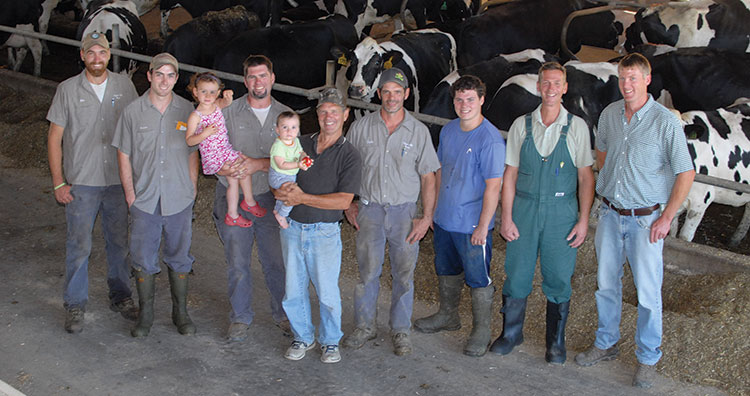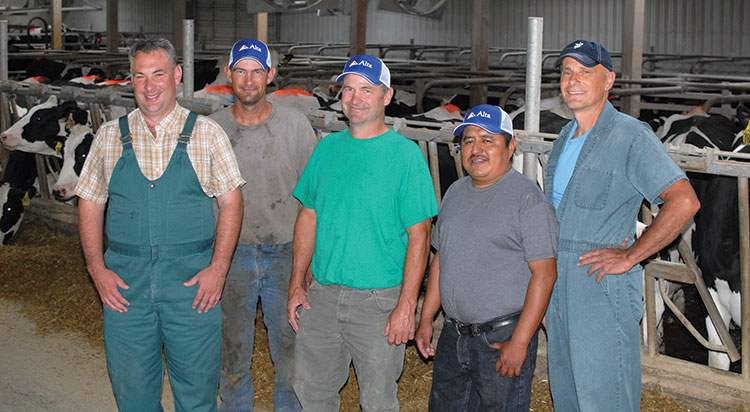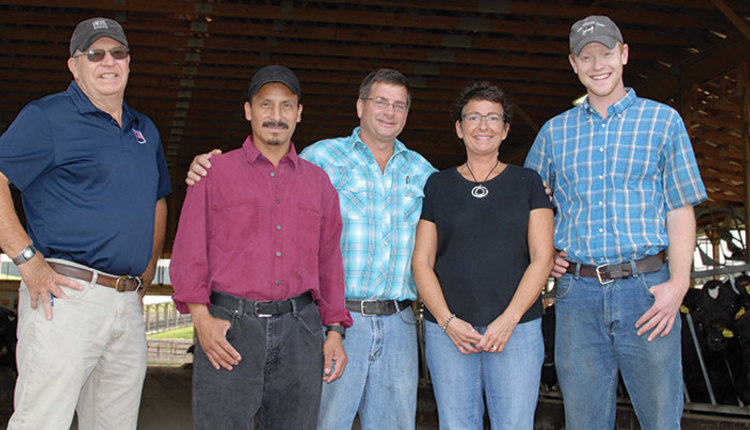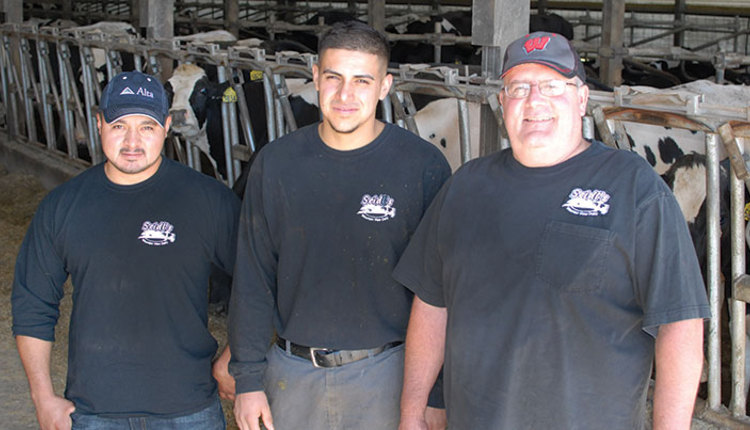A record 128 herds were nominated from 18 U.S. states and Canadian provinces for this year’s ninth annual Dairy Cattle Reproduction Council awards competition. From that pool of nominees, judges reviewed farm statistics and selected 39 herds for a more in-depth review.
In the final phase of judging, a combination of statistical analysis and thorough review by the judging panel narrowed the field down to the top 24 herds. Throughout the entire process, judges only viewed each farm’s data and did not actually learn of herd or nominator names until the final tabulations. Following the judging process, a Hoard’s Dairyman editor assisted the Dairy Cattle Reproduction Council by personally visiting each of the Platinum-winning herds during a one-week window.
It is safe to say that far more than evaluating pregnancy rates (PR) went into judging the awards competition. However, since many readers are interested in statistical measurements, the Platinum herds had pregnancy rates ranging from 36 to 46 percent and all but one of the Platinum, Gold, Silver, and Bronze herds (listed on page 709 were above 31 PR. That’s a far cry from a decade ago when pregnancy rates in the high 20s would have earned Platinum honors. For additional coverage about each farm, go to www.hoards.com/E_reproduction.
What is your voluntary waiting period?

Copperhill: Our voluntary waiting period (VWP) is 68 days. In the future, we may raise first-lactation cows to a higher VWP since their average days open are 12 days less. All of our cows go through the same presynch-ovsynch protocol to ensure cows get a first-service insemination by 92 DIM.
Cows that had retained placentas (RP) or metritis will get “clean out” prostaglandin injections early in lactation before starting presynch. On those cows, if a heat is shown after VWP but before the end of complete ovsynch, we will check for a clean, clear discharge before insemination.
Heifer breedings are determined by the heifer raiser. They breed heifers by size and age. Currently, average age to first calving is 23 months.
Dunlea: We have a 70-day VWP for all animals. We use sexed semen on all first-service, 2-year-old cows.
All heifers are bred at the height of 51 inches measured at the withers. Heifers can reach this measurement anywhere between 10 and 12 months of age. All remaining replacements are bred by 12 months of age regardless of height.
Pfeifer: The VWP is 70 days for all cows and heifers. We will occasionally breed a later lactation cow at 67 to 69 days, if they have a good heat. We begin breeding heifers when they are 13 months old.
Pine Hollow: We apply the same VWP for all cows — 68 days. We begin breeding our heifers at 13 months.
Seidl: We use a 60-day VWP. All cows are inseminated by Day 68. All animals are treated the same. Calves are raised by Hall’s Calf Ranch until 4 to 5 months of age and then they go to Vance Kells Circle-Bar Heifer Ranch in Satanta, Kan. We breed at 12 months of age if the heifers are big enough. By 13 months, all heifers have been bred.
SunBurst: For cows, the VWP is 74 days. That is pretty standard unless a cow had challenges in the postfresh pen.
Heifers start to be bred by 13.5 months of age unless there is one that is behind. Our goal is to average 23.5 to 24 months of age at first calving. We had tried an earlier age at first calving but felt we lost milk and it was harder on the animal at calving time.
How are cows observed for heat?
Copperhill: Heat detection is done primarily by tail chalk and visual observation. We have one herdsman who does the tail chalking, heat detection, breeding, and spends many hours with the cows. Tail chalking is done in the cool early hours of the day, while visual heat detection occurs all day.
Cows are tail chalked using three colors to help identify cows. Florescent pink — used on fresh cows under 30 DIM to keep a closer eye on them. Orange — indicates an open cow, bred, or early pregnancy. Green — verified pregnant cow over 90 DCC (days carried calf). We also have pedometers on every cow.
Heat detection is very important to us. Seventy-five percent of all breedings in the past 12 months were done off of heat detection. The other 25 percent of all breedings were from a timed A.I. synch program.

Dunlea: All first breedings are timed A.I. We tail paint all breeding groups for heat detection. However, no breeding is done before the conclusion of the voluntary wait period.
Pfeifer: We use Detect-Her tail paint daily. All cows get painted upon entering the milking groups. On our farm, cows bred from a detected heat usually have about 5 to 8 percent higher conception rate over timed A.I.
Pine Hollow: All first-services are timed A.I. following the program outlined earlier. Repeat breedings are all done with old-fashion heat detection. We presynch cows coming up for preg check, and if found to be open upon pregnancy exam, they are rebred upon completion of an ovsynch protocol.
Seidl: Heat detection is observed visually in pens. We have predominately one pen in one barn that houses breeding cows. We heat detect daily and do timed A.I. every Thursday. We walk through the pens three times a day. We have 54 percent conception on presynch, 50 percent conception on ovsynch, and 48 percent conception on standing heats.
SunBurst: All cows are on a double ovsynch program for first services and are not inseminated until the program is complete. We observe all cows for estrus. After first A.I. if we observe a confident heat, that cow will be inseminated.
We also are working with Silent Herdsman, a heat detection system on some cows and use that information for determining A.I. breedings. Tail chalk is used on open cows to aid in heat detection and on cows scheduled to be bred that week.
Do you use a synchronization program?
Copperhill: We use presynch ovsynch-11. If cows do not show heat off of the second presynch (prostaglandin) shot, she will get enrolled on ovsynch. We have vet check every other week and start our presynch weekly. If a cow does not show a heat to prostaglandin, she will be checked the following week (as long as it is the week the vet comes.) The vet will determine whether or not she can be started on ovsynch with GnRH. If the cow has no structure on her ovaries, or is cystic, she will be given GnRH that day and then started on ovsynch seven days later.
On the week that we do not have herd check, cows will be started on ovsynch without being checked. The most important part for us is making sure that cows have a good transition period. This ensures that cows are coming in healthy, cycling better, and having better response to the second prostaglandin.
Dunlea: After pregnancy check, all open cows are enrolled in an ovsynch program and given GnRH. Seven days later cows receive prostaglandin, and 24 hours later receive another prostaglandin. Cows then receive GnRH the following evening and are bred the next morning, 14 to 16 hours after GnRH.
The double prostaglandin has improved conception by 4 percent overall with a greater response in second and greater lactation cows. Cystic cows receive GnRH and are rechecked the following week. If the cow has a CL (corpus luteum), she is enrolled in ovsynch.
Meanwhile, all heifers receive prostaglandin if open on pregnancy check. If heifers don’t show a heat after seven days, a CIDR progesterone insert is given.

Pfeifer: All cows automatically are enrolled into the ovsynch program if there is no observed heat after three prostaglandins. Preg check is done via blood analysis at 30 to 36 days postbreeding. All cows are entered onto ovsynch unless they go over 190 DIM or under 80 pounds of milk. All cows receive a GnRH shot when blood is drawn for pregnancy diagnosis. Pregnant cows go off the program, while open cows continue to timed A.I.
Pine Hollow: All cows get the same heat synchronization program. Heifers are only bred off observed heats. Our program has been pretty successful over the years as we have had a preg rate above 35 percent for several years. We have used our current program for some time, but it has evolved just like everybody else through the 1990s and 2000s. We monitor heat detection and conception rates weekly to help keep us focused.
Seidl: We use a presynch/ovsynch program and all cows are inseminated 15 to 16 hours after GnRH. Repeat breeders are checked daily and we follow the a.m.-p.m. breeding rule.
SunBurst: We check heifers and breed on standing heats or chalk reading. Heifers are housed off farm and inseminated by Mark Wallace of Accelerated Genetics. If animals don’t show signs of heat, the vet checks them and gives a prostaglandin treatment.
Cows are evaluated in early lactation to determine if we want her to carry a calf. All individuals not on that list are enrolled into the double ovsynch program with a second prostaglandin treatment.
How are cows bred?
Copperhill: Our herdsman has previous experience tail chalking and breeding, so we do all our breeding in-house. For time off, an A.I. stud representative trained to heat detect with tail chalk will be asked to cover. We like it to be the same A.I. technician who knows the routine of our herd.
We mainly breed in the early morning, when the cows seem to be the most content in the barn. We will follow the a.m.-p.m. rule but on a day that is going to be extremely hot, cows will be bred early in the morning if showing standing heat.
Pedometers are also used to see how long that cow has been standing to determine the best time to breed her. Typically the herdsman does all the heat detection but it always helps to have others keeping an eye out for cows in heat.
Dunlea: Most of the breeding is done by Larry Spencer, Select Sires. On his day off, trained on-farm people breed cows and heifers. We use a once-a-day breeding approach.
Pfeifer: The majority of breeding, 95-plus percent, is done by Ed. Ed’s son, Mark, fills in a little bit. We breed once per day when we use the tail paint.

Pine Hollow: Breeding is done by our farm staff. Only three of us actually do the breeding, and the conception rates vary very little among our group. We generally run in the 45 to 50 percent conception range. We follow the old a.m.-p.m. rule. A focus on heat detection, accurate animal identification, careful record keeping, and consistent breeding techniques are just part of the culture on our team.
Seidl: We have farm personnel, two herdsmen to be specific, trained to breed our cows.
SunBurst: Our herdsman, Alfonso, has a passion for cattle. Alfonso does most of the reproductive treatments and watches for activity. Alfonso and myself (Brian) do a majority of the A.I. work on the cows. If we need back up, we work with Jason Goke from Accelerated Genetics on cows. Cows showing estrus are inseminated on the a.m.-p.m. rule.
What positive changes have you made to your breeding program?
Copperhill: One of the biggest changes that we have made has been adding fans. We added fans over our head to head stalls and feed alley. This has dramatically improved reproduction, milk production, and overall herd health.
Our hoof trimmers, John Montagne and Lucas Kane, come more often than in the past. They come every other week and trim cows every six months. They do an excellent job only trimming what is needed and identifying hoof issues. We invested in our own hoof trimming chute so we can trim cows immediately when found lame. Most recently, we invested in newly designed foot baths to keep infectious diseases under control. Healthy feet keep cows active. Vaccinating with the combination of Vista and Lepto has really helped with EED (early embryonic death) loss.
In the future, we may add fans to the outside rows of stalls to keep cows laying down even in the hot, humid weather. We would also like to add large water troughs in the parlor return alley.
Dunlea: We built a tunnel ventilated barn with steel side walls to stop radiant heat. We also have had solid operating procedures in place to deal with heat abatement and have not found need to make any recent changes. All future milking barns will be similarly built, with cow comfort the foremost requirement.
Pfeifer: The two newer barns have misters. That is a definite benefit. We probably should add misters to the older barn.
Pine Hollow: Over the years we have continually worked to improve our older facilities. The older barns have water beds, rubber floors, and tunnel ventilation. Our newer facilities have sand beds and regular mixing fans. We look forward to adding back scratchers when the dairy economy improves.

Seidl: The barn floors were regrooved and we retrofitted tunnel ventilation. We soak cows in the parlor on hot days with water over the front shoulder and neck delivered with a 3/4-inch PVC pipe. We accomplished that by drilling tiny holes in the PVC pipe and mounted those pipes over cows in the parlor.
SunBurst: With cows and heifers, we try not to stock at over 100 percent capacity. Pre- and postcalving areas are even understocked. We also focus on a calm and quiet, well-bedded environment for cattle. We use fans and sprinklers. That includes dry and prefresh cows in the holding area. A barn with expanded area per animal has benefits. As for the future, we would like to install a positive-pressure tube ventilation system. Heifers are only bred in the morning when tail chalking is done.
How do you confirm pregnantor open cows?
Copperhill: We have pregnancy check every other Friday. We will check cows beginning at 32 days postbreeding. Our herd health veterinarian uses ultrasound to best determine the status of the cow. He will determine what protocol will work best in each cow. There are four options: prostaglandin to breed; GnRH, GnRH, prostaglandin, and GnRH if not cycling or cystic; ovsynch today; or watch for heat and ovsynch in seven days. Cows that get prostaglandin to breed and do not show signs of heat will start ovsynch seven days following prostaglandin.
We also utilize a resynch program. On the Friday that the veterinarian does not come (every other week), every cow that is 29 to 32 postbreeding will get GnRH. This sets them up so seven days later if the vet finds them open, those cows should be good for prostaglandin. That is followed by GnRH two days later and then bred 16 hours after that. This ensures cows are rebred quickly after being found open and helps bolster pregnancy rates.
Dunlea: We have weekly herd checks with our veterinarian who checks for pregnant cows between days 28 to 35 bred using ultrasound.
Pfeifer: We preg-open check with blood. We check cows at 30 to 36 days after breeding. Open cows are timed A.I. We recheck pregnant cows at 90 days.
Pine Hollow: We have weekly vet checks using ultrasound at 31 to 37 days since last service to find pregnant and open cows.
Seidl: Vet check occurs every Monday using ultrasound. The first examination takes place at 30 days, the second check at 60 days, and third at 150 days.

SunBurst: We have preg checks every week using ultrasound. First check starts around 39 days. If confirmed pregnant, they are rechecked at 74 days. At 80 days, the sex also may be determined. Also, the stage of cycles and status of ovian structures are evaluated during ultrasound, as this helps determine how to handle resynch. Animals are rechecked around 193 days to reconfirm pregnancy — this check is done by palpation.
PLATINUM WINNERS (Recipient Nominator listed after farm name)
Copperhill Farm, Jim, Justin, and Kurt Magnan, Fairfax, Vt. Peter Averill, D.V.M., Northwest Veterinary Associates
Dunlea Dairy Farm, Roger and Kerry Dunn, Coudersport, Pa. Tyler Wagner, Alta Genetics
Pfeifer Dairy Farm, Ed Pfeifer, Bucyrus, Ohio Rick Ellerbrock, COBA Select Sires
SunBurst Farm, Brian, Yogi, and Cory Brown, Belleville, Wis. Barry Kleppe, D.V.M., Waunakee Veterinary Service
Pine Hollow Dairy Farm LLC, Locke, N.Y. David Freligh, ABS Global
Seidl Mountain View Dairy, Luxemburg, Wis. Mark Schlaefer, Merck
GOLD WINNERS
Boernview Farm Ltd., Roger Boersen, Luis Vélazquez, herdsman, Gadshill, Ontario, Canada. Drew Tyler, EastGen
Holmesville Dairy Farm, Tim and Penny Holmes, and
Travis and Stephanie Holmes, Argyle, Wis. B.J. Jones, D.V.M., Center Hill Veterinary Clinic
Kloppe Dairy Farm Inc., New Haven, Mo. Scott Poock, D.V.M., University of Missouri
Mapledale Farm, Paul and John Greene, Berlin, N.Y. Carie Telgen, D.V.M., Battenkill Veterinary Bovine PC
Willow Bend Farm, Clifton Springs, N.Y. Amy Cornwell, Zoetis
Zirbel Dairy Farms, DePere, Wis. Gunnar Umnus, North Star Select Sires
SILVER WINNERS
Curtin Dairy, Cassville, N.Y. Amy Cornwell, Zoetis, and Cameron Davis, Semex
Darlington Ridge Farm, Jim DiGangi, Darlington, Wis. Katie Martin, Zoetis
Dziedzic Farm LLC, Paul, Kitty, and Eric Dziedzic, Bliss, N.Y. Rob McNeill, Lakewood Veterinary Service
Glendale Farms, Steve and Cody Kluth, Clintonville, Wis. Daniel Hagman, D.V.M. United Veterinary Service
Maple Ridge Dairy, Stratford, Wis. Megan Weigel, Genex-CRI
Woody Hill Farms Inc., Mark and Jennifer Cary, and Jim Sheldon and Dan Sheldon, Salem, N.Y. Bob Ceglowski, Dairy Health and Management Services
BRONZE WINNERS
Blue Sky Farms (Newport Dairy), London, Ohio Rick Ellerbrock, COBA Select Sires
Lowell Family Farm, Dana and Seri Lowell, Buckfield, Maine Michele Bennett, Gold Star Feed and Grain
Pagel’s Ponderosa Dairy, John T. Pagel and Family, Kewaunee, Wis. Kim Egan, D.V.M., Genex-CRI, and Mark Schlaefer, Merck
Snake River Dairies, Jerry and Mary Lou Tlucek, Melba, Idaho Garth Millard, Vet Logic
Truttmann Dairy LLC, Dan and Shelly Truttmann, Blanchardville, Wis. Christina Beu, Genex-CRI
Wessel Farms, Dave, Joyce, and Rod Wessel, Mineral Point, Wis. Tim Heiring, Genex-CRI











